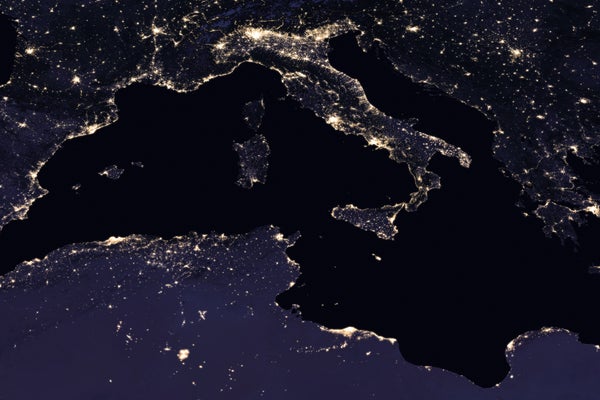Artificial light is often seen as a sign of progress: the march of civilization shines a light in the dark; it takes back the night; it illuminates. But a chorus of scientists and advocates argues that unnaturally bright nights are bad not just for astronomers but also for nocturnal animals and even for human health.
Now research shows the night is getting even brighter. From 2012 to 2016 the earth's artificially lit area expanded by an estimated 2.2 percent a year (map), according to a study published last November in Science Advances. Even that increase may understate the problem, however. The measurement excludes light from most of the energy-efficient LED lamps that have been replacing sodium-vapor technology in cities all over the world, says lead study author Christopher Kyba, a postdoctoral researcher at the German Research Center for Geosciences in Potsdam.
The new data came from a NASA satellite instrument called the Visible Infrared Imaging Radiometer Suite (VIIRS). It can measure long wavelengths of light, such as those produced by traditional yellow-and-orange sodium-vapor street lamps. But VIIRS cannot see the short-wavelength blue light produced by white LEDs. This light has been shown to disrupt human sleep cycles and nocturnal animals' behavior.
On supporting science journalism
If you're enjoying this article, consider supporting our award-winning journalism by subscribing. By purchasing a subscription you are helping to ensure the future of impactful stories about the discoveries and ideas shaping our world today.
.png?w=900)
Credit: Mapping Specialists; Source: “Artificially Lit Surface of Earth at Night Increasing in Radiance and Extent,” by Christopher C. M. Kyba et al., in Science Advances, Vol. 3, No. 11, Article No. E1701528; November 22, 2017
The team believes the ongoing switch to LEDs caused already bright countries such as Italy, the Netherlands, Spain and the U.S. to register as having stable levels of illumination in the VIIRS data. In contrast, most nations in South America, Africa and Asia brightened, suggesting increases in the use of traditional lighting. Australia actually appeared to lose lit area—but the researchers say that is because wildfires skewed the data.
“The fact that VIIRS finds an increase [in many countries], despite its blindness in the part of the spectrum that increased more, is very sad,” says Fabio Falchi, a researcher at Italy's Light Pollution Science and Technology Institute, who did not participate in the study. In 2016 Falchi, along with Kyba and several other members of his research team, published a global atlas of artificial lighting that showed one third of the world's population currently lives under skies too bright to see the Milky Way at night.
The data also cast doubt on the idea that the LED lighting revolution will lead to energy cost savings. Between 2012 and 2016 the median nation pumped out 15 percent more long-wavelength light as its GDP increased by 13 percent. And overall, countries' total light production correlated with their GDP. In other words, Kyba says, “we buy as much light as we are willing to spend money on.”
